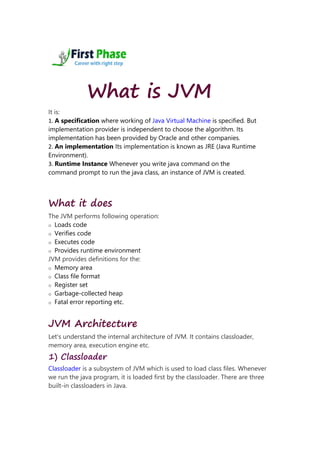
WHAT IS JVM.pdf
- 1. What is JVM It is: 1. A specification where working of Java Virtual Machine is specified. But implementation provider is independent to choose the algorithm. Its implementation has been provided by Oracle and other companies. 2. An implementation Its implementation is known as JRE (Java Runtime Environment). 3. Runtime Instance Whenever you write java command on the command prompt to run the java class, an instance of JVM is created. What it does The JVM performs following operation: o Loads code o Verifies code o Executes code o Provides runtime environment JVM provides definitions for the: o Memory area o Class file format o Register set o Garbage-collected heap o Fatal error reporting etc. JVM Architecture Let's understand the internal architecture of JVM. It contains classloader, memory area, execution engine etc. 1) Classloader Classloader is a subsystem of JVM which is used to load class files. Whenever we run the java program, it is loaded first by the classloader. There are three built-in classloaders in Java.
- 2. 1. Bootstrap ClassLoader: This is the first classloader which is the super class of Extension classloader. It loads the rt.jar file which contains all class files of Java Standard Edition like java.lang package classes, java.net package classes, java.util package classes, java.io package classes, java.sql package classes etc. 2. Extension ClassLoader: This is the child classloader of Bootstrap and parent classloader of System classloader. It loades the jar files located inside $JAVA_HOME/jre/lib/ext directory. 3. System/Application ClassLoader: This is the child classloader of Extension classloader. It loads the classfiles from classpath. By default,classpath is set to current directory. You can change the classpath using "-cp" or "-classpath" switch. It is also known as Application classloader. 2) Class(Method) Area Class(Method) Area stores per-class structures such as the runtime constant pool, field and method data, the code for methods. 3) Heap It is the runtime data area in which objects are allocated . 4) Stack Java Stack stores frames. It holds local variables and partial results, and plays a part in method invocation and return. Each thread has a private JVM stack, created at the same time as thread. A new frame is created each time a method is invoked. A frame is destroyed when its method invocation completes. 5) Program Counter Register PC (program counter) register contains the address of the Java virtual machine instruction currently being executed.
- 3. 6) Native Method Stack It contains all the native methods used in the application. 7) Execution Engine It contains: 1. A virtual processor 2. Interpreter: Read bytecode stream then execute the instructions. 3. Just-In-Time(JIT) compiler: It is used to improve the performance. JIT compiles parts of the byte code that have similar functionality at thesame time, and hence reduces the amount of time needed for compilation. Here, the term "compiler" refers to a translator from the instruction set of a Java virtual machine (JVM) to the instruction set of a specific CPU. Types of Variables There are three types of variables in Java: o local variable o instance variable o static variable 1) Local Variable A variable declared inside the body of the method is called local variable. You can use this variable only within that method and the other methods in the class aren't even aware that the variable exists. A local variable cannot be defined with "static" keyword. 2) Instance Variable A variable declared inside the class but outside the body of the method, is called an instance variable. It is not declared as static. It is called an instance variable because its value is instance-specific and is not shared among instances. 3) Static variable A variable that is declared as static is called a static variable. It cannot be local. You can create a single copy of the static variable and share it among all the instances of the class. Memory allocation for static variables happens only once when the class is loaded in the memory.